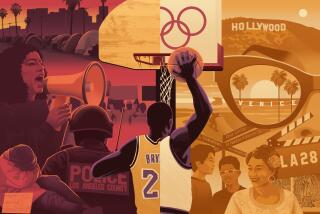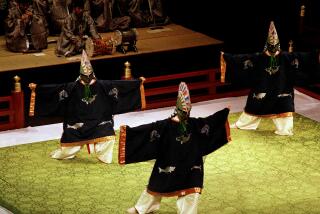Have the Arts Helped Heal L.A.? : Some See Empowerment, Others See Futility, Still Others Exploitation
- Share via
This is the way Belmont High School junior Elathen Walton, 16, first described the image he created for an animated video project done a few months after the Los Angeles riots:
“I just made a little abstract art bubble, floating around the screen. It erupted and burst into some little water drops, and that was the end,” he said.
But when the conversation began to turn to the riots, Walton realized the bubble wasn’t so abstract after all. “I was scared, I was really scared,” the South-Central resident remembered. “I couldn’t go out of the house. I live at Raymond and Vernon. . . . That’s like two miles from where it started.” He paused. “It was connected with a lot of things, really,” he added slowly. “I guess I was just trying to float away like a bubble, from all my problems.
“When I hold my emotions in too long, I get sick. If you hold it in too long, eventually you’ll burst.”
Walton and other students at several area high schools have been working since last September on projects with artist-teacher Mar Elepano, who received a grant from the Los Angeles Department of Cultural Affairs’ Arts Recovery Fund. The fund was established just after last spring’s unrest to provide immediate funds to area artists and arts organizations. Since last September, the department has awarded nearly $474,000 in small grants ranging from $1,500 to $3,000. The J. Paul Getty Trust, joining other donors, gave $100,000 to the Recovery Fund.
Just as Walton is struggling to understand the significance of the bubble, Los Angeles area artists are only beginning to evaluate the healing effect of the Cultural Affairs’ grants program--as well as scores of other such arts efforts citywide. Some point to the empowerment engendered by the projects, but one prominent local writer likened the efforts to “trying to empty the ocean with little spoons.”
The anniversary of the civil unrest, April 29, is just two days away--but widespread arts involvement, which took a few months to gain momentum, has not quite reached its first birthday.
A few artists are ready to begin looking back. On Friday, artist Seth Kaufman will present “Dwelling in Rebellion/A Year to the Day” at the Zero One Gallery on Melrose Avenue. The show features sculptural assemblages made of melted and burned artifacts salvaged from the riot wreckage. During the May 6-8 dance festival “Black Choreographers Moving Toward the 21st Century” at downtown’s Japan America Theatre, Shakiri’s riot-inspired dance/theater work “With My Face on Their Faces” will be presented.
Still others have already moved into “revival” mode: Dwan Smith’s play “WINDOWS . . . Mama, Why Is L.A. Burning,” first presented last July at the Boys & Girls Club of San Fernando Valley, reopened Friday at the New Ivar Theater in Hollywood; Mari Sunaida’s production “Soul to Seoul,” a dialogue between the African-American and Korean-American communities first presented in March, 1992, will this time be presented with the added context of the city’s riot experience at UCLA’s Rolfe Hall Wednesday, the anniversary of the eve of the uprising.
And some are still struggling to get off the ground. Communications consultant Torrey Bridgman, who is also a painter, has joined with other business people and artists to form Operation Communication, which is working with downtown’s Museum of Contemporary Art to create a street art exhibit utilizing the exterior walls of MOCA’s Temporary Contemporary in Little Tokyo as a painting surface. The idea, he said, is to bring the established, affluent arts community together with local graffiti artists. “What better way for the two factions to get together than for MOCA to do a show?” he said.
The National Endowment for the Arts, which provided a $50,000 emergency grant to help fund Arts Recovery, called the program “too new” to be evaluated, and plans to wait until September to document its effectiveness. Diane Mataraza, the NEA’s program director for local arts agencies, said the NEA was poised for yet another emergency effort if April 17’s verdicts announcement in the Rodney G. King case had sparked further violence.
“In a sense, (some of) these were bridge grants to make sure that the small and mid-sized arts organizations didn’t . . . go out of business,” Mataraza said. “That was the reason we were able to turn this around so quickly--it was a very singular focus.”
While the NEA is waiting to pass judgment, the fledgling effort to use art to heal the city, already has vocal supporters and detractors in Los Angeles.
Cultural Affairs Department general manager Adolfo Nodal said the department has received “very positive feedback” and noted that 70% of the recipients were first-time grantees. “It isn’t just finger-painting on walls--it is about having artists working with communities and developing their art and their organization as well,” he said.
Nodal brushes off naysayers who might call the city’s efforts merely cosmetic. “Some of it is cosmetic, sure. What’s wrong with cosmetic?” he asked. “There’s a great need to do a face-lift on this town.”
U.P. (Urban Pride), which works in collaboration with such groups as the Baha’i Assembly of Los Angeles on various outreach programs, has put 700 kids to work on just such a “cosmetic” project: painting flower murals on burned-out buildings. But urban designer and U.P. president David Greenberg said it went more than skin-deep.
“I told these kids their work would be seen by the whole city--hundreds of thousands of passing motorists--and with all the media attention, they had a real sense of doing something for their city,” Greenberg said. “It was empowering them to affect the environment they live in. The coming together of black, white and Latino kids also gave them a sense of being part of something bigger than themselves. It boosted their self-esteem.”
Greenberg said photos of the murals may appear in a slide show/video for another project that grew out of the riots: Anna Deavere Smith’s theater piece “Twilight’s Last Gleaming: Los Angeles, 1992,” which will open at the Mark Taper Forum June 3.
Others arts and community leaders are less optimistic. James Bronson of L.A. Black Playwrights called mural painting “busywork” and thinks large amounts of money need to be funneled into the arts before an impact can be made. And writer Wanda Coleman, who after the riots guest-edited an edition of High Performance magazine called “The Verdict and the Violence,” said she doubts that the current emphasis on art will last long enough.
“It is too soon to tell,” Coleman said. “But . . . I’m pretty cynical about what’s happening in L.A. in terms of lack of recovery, and that includes virtually all of the institutions. Everyone is sort of showboating right now, and going out of their way to sniff out whatever they can, of color, to parade it, or include it.”
As a young person in Watts following the 1965 riots, Coleman said she felt “exploited” by those claiming to want to help the youth. “I hate to see that kind of exploitation repeated,” she said. “A lot of the sharks with deep pockets who were around after Watts burned are still around, and their pockets are just as deep.
“I don’t want to sell short the people who are really, sincerely trying to make their statement, sincerely groping to find solutions, but I feel that those people are trying to empty the ocean with their little spoons.”
Paul Jones, interim target-area manager of the South-Central office of Youth Gang Services, said the arts effort so far has not been far-reaching enough.
“It did not reach the types of kids that are really, seriously in need of that kind of support system,” Jones said. “I think it’s the age-old problem of getting the wrong people to try and implement what might be a new idea.” Jones said that the tight city budget might better allocate funds to athletic programs.
He added that arts programs don’t necessarily address the problem: “I spoke with a gentleman . . . who claimed to be an artist, wanting to get some young people to train them to become artists, telling me about the money they would make in the future (as artists). I explained to him that many of these young people are sole supporters of a family themselves, so they get out there and hustle. ‘How about putting together an art program that would give them a stipend?’ He couldn’t understand that.”
But Walton and his classmates at Belmont High, Sarah Mom Taing, 17, and Frank Tamayo, 18, say they have benefited from the effort. “I was so upset with seeing all the things like murders and rage on the streets--I tried to show what my anger sort of looked like,” said Tamayo, who for his video created a cartoon character who was bald, tattooed and “kind of mean-looking,” but had a heart of gold. Tamayo also belongs to a neighborhood youth movement called Straight Edge, which opts to support the arts and other positive efforts instead of “hanging out on the streets.”
“I think it does help. . . . I think it is good for you to express your feelings,” Tamayo said. “Some people can’t express themselves through words; they express themselves through drawings and paintings and sculpture.”
Taing said she enjoyed connecting with other students through the video project, but shied away from dealing directly with the riots, instead creating a comic video about a little dinosaur. “If I were to do (art) about the riot, what would I do?” she mused. “Should I do something about somebody going into a shop, and stealing something? What meaning would it have? All I really knew was people were looting, people were burning, and they were using Rodney King as an excuse.”
The Arab arts group Al-Funun Al-Aribiya received a $3,000 recovery grant to present a recent afternoon of Arab musicians, poets and other artists at the California Afro-American Museum. Group spokeswoman Fadwa El Guindi said the grant gave the Arab community, not specifically targeted by the riots, a chance to play a role in the healing effort.
“Groups that are usually invisible used that opportunity (the arts grants) to become visible, and join other ethnic groups,” El Guindi said. “(Arabs) were shaken by the Gulf War, the Palestinian situation, the hate crimes in the U.S. . . . the fires in L.A. brought all this, in graphic expression, back to them. They wanted very much to be part of the Los Angeles scene.”
Gordon Davidson, artistic director of the Mark Taper Forum/Center Theater Group, which commissioned Anna Deavere Smith’s forthcoming production, said that “the jury is still out.” “I do know this,” he said. “I really believe that we, as a cultural organization, are not, and will not, be the same as we were before the events of last year. We intensified our efforts, and are more keen to effect change in the areas where we can help: in the world we create, the audiences we serve, and maybe most important of all . . . to make sure the work influences and helps change the audiences that come to see it.”
Playwright Sunaida cautioned against developing a business-oriented “success” standard for the arts activities spawned by the riots. “Take the money part out of it,” she said. “I saw the result. The only way to experience it is direct experience--you can see it when somebody is engaged. ‘Do they get a recording contract?’--that’s not fair. That (type of standard) is being applied to the arts. I want a little time. Those things that I feel good about are not necessarily about money.”
More to Read
The biggest entertainment stories
Get our big stories about Hollywood, film, television, music, arts, culture and more right in your inbox as soon as they publish.
You may occasionally receive promotional content from the Los Angeles Times.










